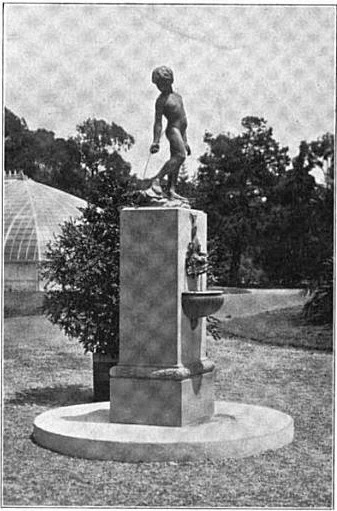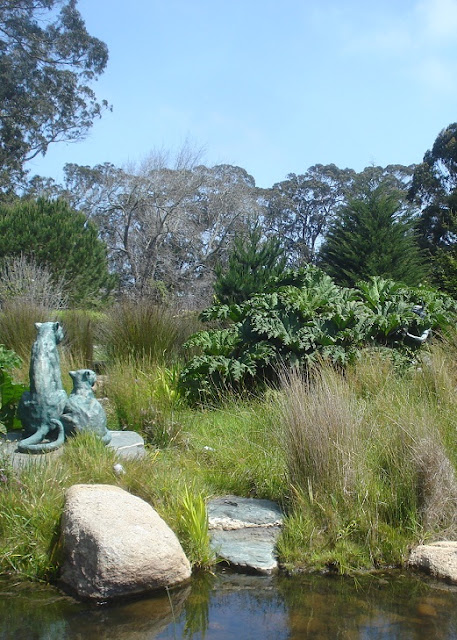A few of Cummings' works - a drinking fountain and a bust of Rueben H. Lloyd can no longer be found in the park. As the photograph below shows, this drinking fountain was adjacent to the Conservatory of Flowers.
Drinking Fountain - Golden Gate Park (near the Conservatory of Flowers)
(no longer extant)
Another piece of Cumming's artwork that was once in the park was an 8 foot high statue of Rueben Lloyd located at his namesake Lloyd Lake nearby the Portals to the Past.
head of the Statue of Rueben H. Lloyd (source: Chronicle April 27, 1913)
(no longer extant)
Lloyd H. Rueben, a prominent San Francisco attorney and Park Commissioner who was also active in the local chapter of the Independent Order of Odd Fellows. The San Francisco Art Commission apparently voted to deaccession the this work on April 13, 2006.
Earl Cumming's sundial at the DeYoung Museum, created in 1905, was installed and dedicated in 1907

The Golden Gate Park Sundial (keeping reasonably good time at 10:53 AM)
Commissioned by the Society of Colonial Dames of America it depicts three colonial navigators at its top: Fortuno Ximenes (credited with discovering Baja California in 1834), Juan de Cabrillo (who explored California in 1542) and Sir Francis Drake (who did likewise in 1579).
Nearby, also outside of the DeYoung Museum are Cummings' sculptures for the Pool of Enchantment.
A pair of pumas (on the right) listen to an Indian boy playing a pipe (center left).
The artist's son, Ramy (R. Ramsdale Cummings), later recalled his discomfort at posing naked in a chilly art studio for this work.
Another work by Cummings, "Neptune's Daughter," is nearby in the adjacent Children's Garden of Enchantment. This work along with "Portrait of an Artists' Wife," "Child's Head," and "San Francisco Gold Star" (probably the Doughboy statue below) were displayed at the Legion of Honor Sculpture Exhibit of 1929.
This statue made national news when it was repaired after being vandalized. In 2011 somebody pulled an arm off the statue. According to the Wall Street Journal the DeYoung museum reported the crime to the police and quietly removed the statue sans arm. Around a year later unknown members of the public spotted the stray bronze arm in some bushes and returned it to the museum. In the mean time the museum had filed an insurance claim and sent the 2000 pound damaged statue to the insurer in England. The insurer later generously gifted the restored work back to the DeYoung.
Perhaps Cummings' most prominent work is the sculpture of a cougar fighting a snake at the Rideout Fountain located in the center of the Music Concourse.
This 1926 was commissioned by a banker's widow, Corinne Rideout, who donated a portion of his estate to commission the fountain and sculpture.This followed a 1908 commission by another widow, Susanna Brown, to memorialize her husband. Here he created the bear and mountain lion book-ending the gate that greets visitors as they enter Golden Gate Park from 8th Avenue at Fulton Street.
Cummings' other works in Golden Gate Park are specimens of what art historians have characterized as the "statue-mania" of the late 19th and 20th centuries. Julian Bell describes this exemplification of national and civic pride as "an age when monuments to rulers, benefactors, legendary founders or lamented heroes sprouted in every available urban space."
This concept probably originated with Maurice Agulhon who analyzed the characteristics of this statuomanie. He noted the prevalence of solid media like stone and bronze. Often there is the use of a pedestal and the subject is depicted (often standing) in a realistic manner reflecting their profession or position in the world. We have described other manifestations of this phenomenon in entries about the Verdi and Beethoven monuments in the Park.
The most obvious presentation of this tendency in Cummings' work is his imposing statue of poet Robert Burns in the Park that was unveiled just a few months before the 1906 Earthquake and Fire. The sculpture commissioned by the Scottish Citizens Committee, nearly 10 feet tall by itself, is placed on a base designed by San Francisco City Hall architect Arthur Brown.
As the Verdi and Beethoven statues were focal points for the nationalism of the Italian and German communities in the Bay Area, likewise the statue of Robert Burns played this role for the Scots. There was a time when there was an annual observation of Robert Burns' birthday at the statue every January 25 by the local Scots community.
The "Doughboy" statue, also known as the "Gold Star" statue," was created in 1928 and bought by the Native Sons and Daughters of the Golden West in 1930. As a war memorial it does not look very martial with a hat-less soldier holding a wreath against his chest. The statue on its rock base is flanked by two flagpoles. Names of the fallen soldiers in both World Wars are recorded on the base. As Jennifer Wingate describes in her work on "doughboy" statues, a work like this serves to condense the "attitudes about war, nationalism, heroism, and loss" of the time
The other memorial statue in Golden Gate Park that Cummings created is rather atypical and delightful. It is a nearly life-size figure of John McLaren who was superintendent of the Park for 53 years.
This statue is fittingly located in the John McLaren Rhododendron Dell. It was completed some time before McLaren's death. A 1926 newspaper article reported that the statue was kept in storage in the park because the subject "never wanted to come face to face with himself while he was living." The work is unusual and endearing because McLaren is approachable. He is not placed on a pedestal and appears lost in thought, and completely unpretentious.
In a 2008 article, a San Francisco Chronicle describes M. Earl Cummings as being "all but forgotten." That may be so, but his work, almost all of it displayed without attribution, has left a substantial imprint on the city of San Francisco.
Agulhon, Maurice, "La 'statuomanie' et l'histoire," Ethnologie française (1978), pp. 145-172. [Available through JStor]
American Sculpture: The Collection of the Fine Arts Museums of San Francisco by Donald L. Stover (Fine Arts Museums of San Francisco, [1982?]).
"Big Bronze Sundial is Presented to City," San Francisco Call (October 13, 1907) [found in the California Digital Newspaper Collection]
Blum, Walter, "What's Where in the Park," Sunday San Francisco Chronicle and Examiner (March 26, 1972), pp. 24-39. [found in the San Francisco Chronicle Historical and Current database]
"Cummings Shows Fine Work At Exhibition," San Francisco Chronicle (May 12, 1929), D5.
Golden Gate: The Park of a Thousand Vistas by Katherine Wilson (Caxton Printers, 1947)
Mirror of the World: A New History of Art by Julian Bell (Thames & Hudson, 2007).
Morch, Albert, "Ramy the Aquarian Emerges," San Francisco Chronicle (May 27, 1973), B1. \
San Francisco Civic Art Collection: A Guided Tour to Publicly Owned Art of the City and County of San Francisco (The Arts Commission of San Francisco, 1989).
San Francisco, The Bay and Its Cities, compiled by workers of the Writers' Program of the Work Projects Administration in northern California (Hastings House, 1947).
San Francisco's Golden Gate Park: A Thousand and Seventeen Acres of Stories by Christopher Pollock (Westwinds Press, 2001).
"Statue of Bobbie Burns to Be Given City," San Francisco Chronicle (January 28, 1906), 52.
"Statue Will Honor Heroes," San Francisco Chronicle (March 6, 1930), 5.
"To Honor Reuben H. Lloyd: Statue Will Stand In Park," San Francisco Chronicle (April 27, 1913), 28.
Wingate, Jennifer, "Over The Top: The Doughboy in World War I Memorials and Visual Culture," American Art vol. 19, no. 2 (Summer 2005), pp. 26-47 [Available in JStor]
Wolfe, Alexandra, "A Museum Wins the Arms Race," Wall Street Journal (September 5, 2014).
"Worker in Bronze: Oakland Metal Worker Makes Statues in Bronze," San Francisco Chronicle May 9, 1926, 39.



























